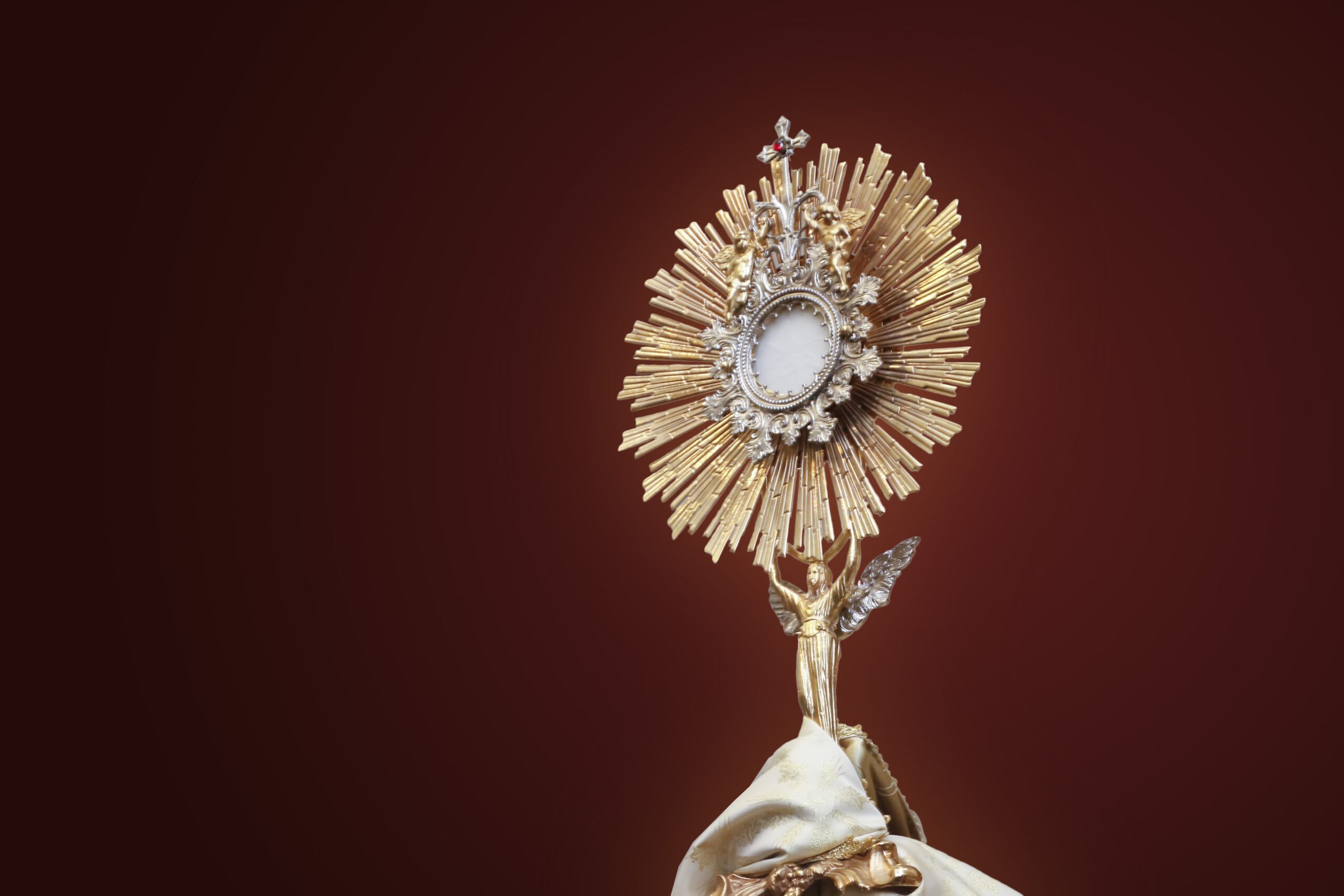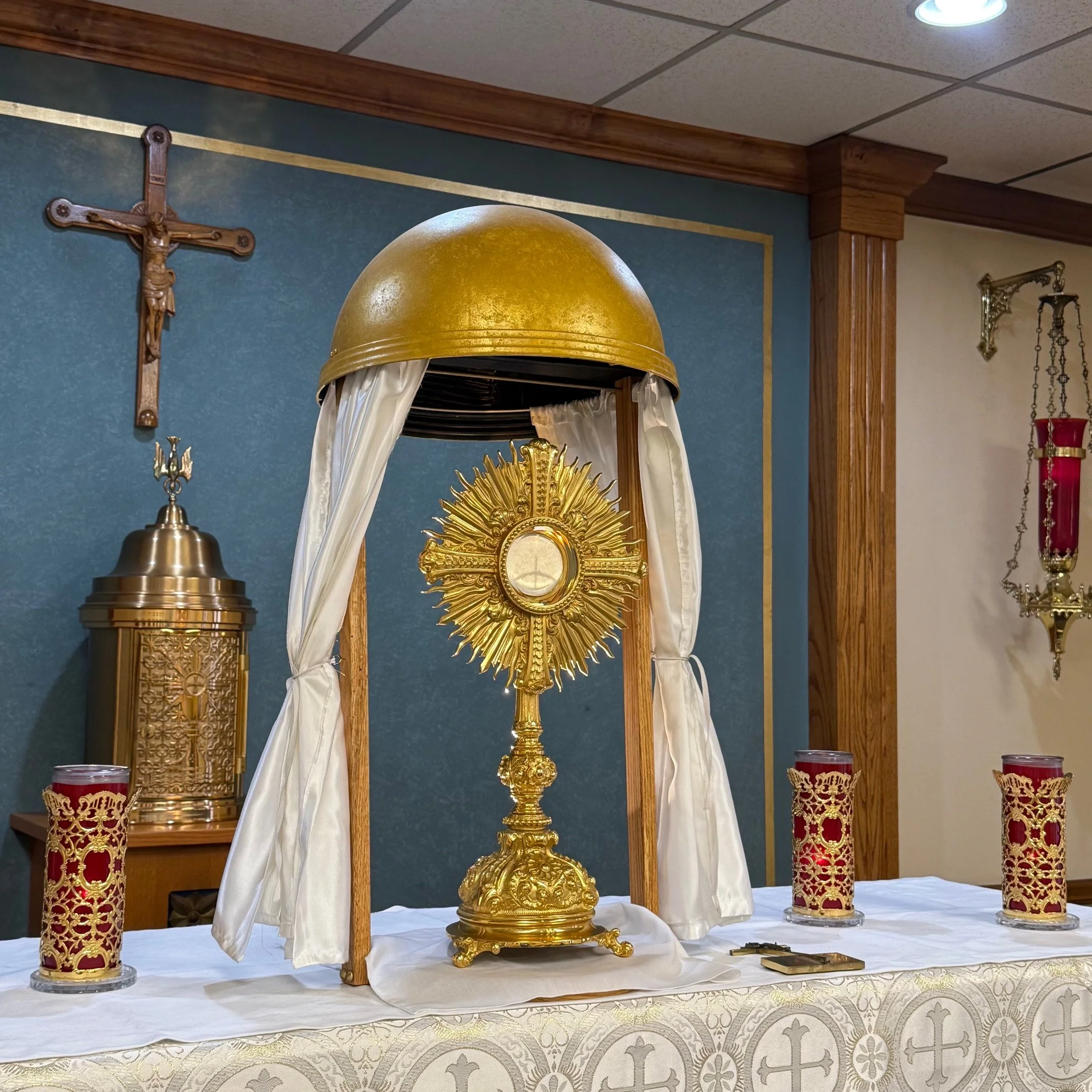
“The Eucharist is a fire which inflames us.”
Saint John Damascene
Open 24/7, the Adoration Chapel welcomes visitors and committed Adorers.
Adorers are needed to commit to a weekly holy hour.
Please call the Chapel Hotline for closings in case of inclement weather: (717) 243-4875.
Contact: Doug Henschel 610-207-8654 or Maria Key 717-713-8499.
St. Katherine Drexel Adoration Chapel
Without faithful, committed adorers, exposition of the Blessed Sacrament would be impossible!
Once we believe Christ is really present in the Holy Eucharist, it is only logical to conclude we should worship Him.
Will you make a commitment to visit our Lord each week at a regularly scheduled hour?
Frequently asked questions
We know that many of our parishioners may have questions about adoration. We’ve assembled a list of common questions that we’ve heard. If you have a question or concern that isn’t addressed here, please let us know. You can email our coordinator at: saintpatrickchurch@sites.weadorehim.com.
-
Adoration is worship due to God alone. Since the Eucharist is the Body, Blood, Soul and Divinity of the Lord, Jesus Christ, we have a duty to adore Him in the Blessed Sacrament (His True Presence). During Eucharistic Adoration, the Eucharist is displayed in a monstrance (a vessel used by the Church to display the consecrated Host) flanked by candles in which the Blessed Sacrament is exposed and adored by the faithful. It is a practice that flows from, and extends the worship that begins in the Holy Sacrifice of the Mass.
-
Perpetual Adoration is the devotion whereby the faithful unite in taking hours of adoration before the Most Blessed Sacrament, both during the day and throughout the night, seven days a week.
Perpetual Adoration is YOUR personal time with Jesus Christ.
-
Christ in the Tabernacle: The consecrated Host is reserved in the tabernacle, typically behind a closed door, often with a veil or curtain. Christ is truly, really, and substantially present, but hidden under the appearance of bread. Prayer before the tabernacle is an act of faith in His Real Presence, and is seen as a continuation of the sacrifice and meal of the Mass. This devotion emphasizes union with Christ as the sacrificial victim, and honors His ongoing intercession for us. The presence is just as real, but less immediately perceptible to the senses.
Exposition allows for a more personal experience with Jesus Christ in the Eucharist. Being able to see Jesus exposed before us, instead of hidden in the tabernacle, helps us to better contemplate the Mystery of His Incarnation. Jesus waits for us, as a prisoner of love, in our chapel. He waits, in His most vulnerable state, and gives us a chance to see with our eyes, what generations have only dreamed of…God before us! This is the privilege of discipleship:
Turning to the disciples in private he said, “Blessed are the eyes that see what you see. For I say to you, many prophets and kings desired to see what you see, but did not see it, and to hear what you hear, but did not hear it.” (Luke 10: 23-24)
Questions about Adoration at Saint pATRICK
-
Our chapel, the Katherine Drexel Perpetual Adoration Chapel, is located in the rear of St. Katherine Drexel Hall (i.e. the rectory). Use the green door at the rear of the parking lot. Go up a half flight of stairs.
-
You may visit for as short or long a period as you like, as long as your time is spent in prayer or contemplation.
Committed adorers make a commitment to the Lord to be with Him for a specific one hour shift each week. Adorers may take as many of these one-hour shifts as they like.
-
While you should make every effort to spend your hour with the Lord each week and try to be reliable to others in your hour, we know your schedule will change. First check with other committed adorers during your hour. These are your “prayer partners”, and if one of them will be there, that is sufficient. Next, if you have a friend or family member who would be willing to substitute for you, ask them. Finally, put in a sub request through our online scheduling platform, Saintpatrickchurch.WeAdoreHim.com. If that fails, contact your hour captain to let them know you can’t make it. If you are sick or have a last-minute emergency, let your hour captain know as soon as possible. It’s a good idea to have both your hour captain’s phone number, and the phone number of the adorer before your hour in your contacts.
If this is a particular concern of yours, consider choosing an adoration hour that already has at least one committed adorer. Then you already have a “prayer partner.”
-
The exposition of Jesus in the monstrance leaves Christ vulnerable and must be properly attended at ALL times. Since He is exposed out of love for us, it is our duty to make sure He is protected. For that reason, at least one person must be in the chapel while He is exposed. If an emergency arises, call your hour captain or a coordinator and arrangements will be made to relieve you with another adorer.
-
During the day, the chapel is open to all. From 9 pm to 6 am the exterior door is locked and only adorers with a code will be allowed in. If you would like to make a nocturnal or night-time visit, please stop by the parish office during open hours to get the code. It will not be given out over the phone. This will help create a safe environment at night. Extensive video surveillance also covers the exterior and interior of building. There is a telephone in the hall for emergencies. Finally, it is our goal to have more than one adorer at all times.
-
Whatever is comfortable and modest. Some women may choose to wear a veil, but it is not required.
-
You have a lot of choices here. You may pray informally, or formal/traditional prayers, sit in silence, read the Bible or other spiritual book, pray the rosary, meditate on the Eucharist, contemplate the saint’s lives, keep a prayer journal, listen to a recording of your favorite Catholic speaker quietly through your headphones, or simply sit in silence. The only requirement is that your focus is on Our Lord, and your relationship with Him. That will be different for each person. Typically, this is a time for silent prayer. However, if a group shares an hour, it is also appropriate to share vocal communal prayer and hymns such as the rosary, divine mercy chaplet, and most especially, the liturgy of the hours.
There are books and other prayer aids in the chapel for your use. In addition, our parish library is just across the hall and always open.
This is your personal time with God. Relax and open your heart as you would to your closest friend, which He is. Christ says we are no longer servants but friends, so just spend some time with your friend. He loves you and is calling you.
St. John Vianney was always fond of telling a story of when he asked a humble farmer what he was doing in Church all the time in the morning before work. And the farmer replied: “I look at the good God, and he looks at me.” (The Curé d’Ars by Abbé Francis Trochu, Translated by Dom Ernest Graf, OSB, Baronius Press, 2015.).
-
A simple genuflection of one knee is all that is required before Jesus exposed in the Blessed Sacrament. However, it is a very common practice to bow on two knees. Reverence, discreet respect for other adorers and your own physical abilities should be your guide.
-
Yes, absolutely! Adoration is for children and whole families too. Small children love to make a quick “Hello Jesus” visit to the chapel. As they grow, so does their ability to stay longer and sustain silent prayer. There is a basket of children’s books in the library across the hall. It is also acceptable for small children to color a religious picture or other similar quiet activity. Kids under the legal age cannot be assigned an hour on their own, but they may adore with their family. You may also see that when your children are old enough to move about town on their own, they will make their own visits.

“From the Eucharist comes the strength to live the Christian life with zeal and to share that life with others.”
— Saint John Paul II

